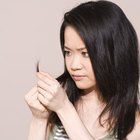
Hair is one the most sensitive parts of the body--it reacts to changes in mood, environment and lifestyle. Most people will experience a change in their hair color when they are children and again when they are senior citizens. Genetics also plays a vital role in hair color.
Causes
Scientists are still unsure of why natural hair changes color. One theory is that certain genes in human DNA are triggered to start producing darker hair as adulthood approaches, and again to cease producing hair pigment altogether once the body starts to age. Another theory is that hair color reflects changing melanin levels, which adds color pigment to the skin and hair. As the body ages, melanin levels decrease, which may contribute to gray hair.
Time Frame
In July 2000, a Prague-based study called "Change in Hair Pigmentation in Children from Birth to 5 Years in a Central European Population" found that children of both sexes had a prevalence of dark hair within the first six months of their lives. From nine months to two-and-a-half years of age, the hair color in the children grew progressively lighter. It was noted that from three to five years of age, the hair began to darken again.
Considerations
Scientists have linked external factors such as sun exposure, washing with alkaline soaps and frequent sea-bathing with natural hair lightening or darkening. Internal factors such as hormones and genetics also contribute to changes in natural hair color.
Related Articles

How Does Facial Hair Grow Get Lighter ...

Dominant & Recessive Hair Colors

Can Supplements Reverse Gray Hair?

Zinc & Gray Hair

Can Hair Dye Cause Severe Itching of ...

Types of Hair Treatment

What Are the Causes of Graying Hair?

What Are the Causes of Hair Shedding in ...

The History of Hair Dye Colors

Why Do Men Lose the Hair on Their Legs ...

The Effects of Vitamin-D Deficiency on ...

Can Age Spots Be Reversed?

The Effects of Divorce & Introducing a ...

What Are the Dangers of Men's Brazilian ...

Difference Between Women's Rogaine & ...

The Effects of the Silent Treatment

Why Do Men Grow Hair on Their Back?

What Foods Provide Calcium D-Glucarate?

About Hair Bleaching

Chemicals That Stop Testosterone ...
References
Writer Bio
An accredited makeup artist, Stacey Richardson has written for various fashion, beauty and lifestyle publications since 2007. Her work has appeared both in print and online for a variety of international companies. Richardson has a Bachelor of Design, honors, with a major in fashion communications, and a TEFL diploma, specializing in business communications.
Photo Credits
portrait of an old woman image by studio vision1 from Fotolia.com